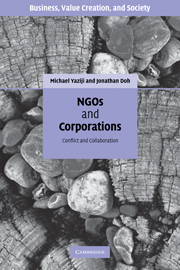Book contents
- Frontmatter
- Contents
- List of figures
- List of tables
- Preface
- Foreword
- Acknowledgments
- Part I Understanding NGOs
- Part II NGO advocacy campaigns
- Part III Corporate–NGO engagement
- 7 Corporate–NGO engagements: from conflict to collaboration
- 8 Globalization, multinationals and NGOs: the next wave
- Case illustration: conflict diamonds
- Case illustration: Unilever in Indonesia
- Case illustration: microfinance and poverty reduction
- Part IV The future of corporate–NGO relations
- Index
- References
7 - Corporate–NGO engagements: from conflict to collaboration
Published online by Cambridge University Press: 13 January 2010
- Frontmatter
- Contents
- List of figures
- List of tables
- Preface
- Foreword
- Acknowledgments
- Part I Understanding NGOs
- Part II NGO advocacy campaigns
- Part III Corporate–NGO engagement
- 7 Corporate–NGO engagements: from conflict to collaboration
- 8 Globalization, multinationals and NGOs: the next wave
- Case illustration: conflict diamonds
- Case illustration: Unilever in Indonesia
- Case illustration: microfinance and poverty reduction
- Part IV The future of corporate–NGO relations
- Index
- References
Summary
Corporate–NGO engagement has gained increased attention in both academic and practitioner circles. As discussed in Section II of this book, some NGOs have explicitly targeted corporations, seeking to pressure companies and managers to assume greater responsibility for the negative spillovers of their actions. It is in this context that many corporations confront NGOs and undertake formal or informal relationships with organizations that may have targeted and continue to target these very same companies with campaigns.
Collaborations among corporations and NGOs are now so common that they are a growing subject of management research. For NGOs, partnerships with corporations may yield financial, human resource and reputation benefits. For corporate partners, relationships with NGOs provide access to skills, competencies and capabilities that support their CSR efforts and are otherwise unavailable within their organizations or from alliances with for-profit firms. These “combinative” capabilities have the potential to provide both partners with discernable benefits.
One challenge in reviewing the literature and contributions on corporate–NGO engagement, especially those involving collaborative or cooperative relations, is that “studies of CSSPs [cross sectoral social partnerships or corporate–NGO relationships] emerge from various disciplines such as organization studies, public policy and administration, economics, nonprofit management, health care, education and the natural environment.” In this chapter, we review this literature in order to frame the interactions that characterize corporate–NGO engagement.
- Type
- Chapter
- Information
- NGOs and CorporationsConflict and Collaboration, pp. 123 - 145Publisher: Cambridge University PressPrint publication year: 2009
References
- 1
- Cited by



